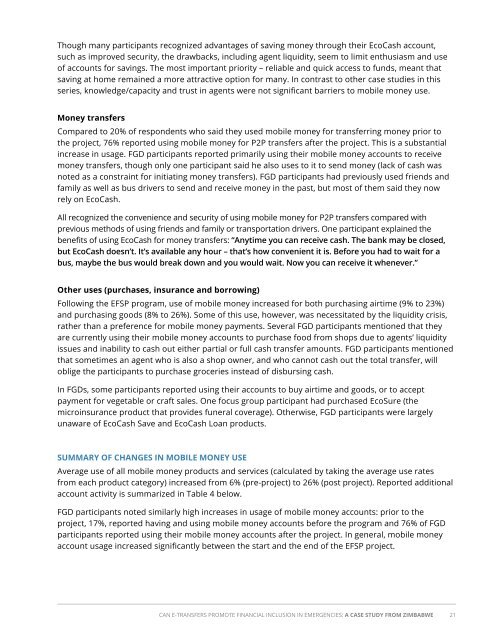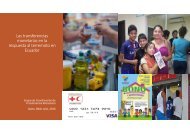Simatelele
2lF850q
2lF850q
Create successful ePaper yourself
Turn your PDF publications into a flip-book with our unique Google optimized e-Paper software.
Though many participants recognized advantages of saving money through their EcoCash account,<br />
such as improved security, the drawbacks, including agent liquidity, seem to limit enthusiasm and use<br />
of accounts for savings. The most important priority – reliable and quick access to funds, meant that<br />
saving at home remained a more attractive option for many. In contrast to other case studies in this<br />
series, knowledge/capacity and trust in agents were not significant barriers to mobile money use.<br />
Money transfers<br />
Compared to 20% of respondents who said they used mobile money for transferring money prior to<br />
the project, 76% reported using mobile money for P2P transfers after the project. This is a substantial<br />
increase in usage. FGD participants reported primarily using their mobile money accounts to receive<br />
money transfers, though only one participant said he also uses to it to send money (lack of cash was<br />
noted as a constraint for initiating money transfers). FGD participants had previously used friends and<br />
family as well as bus drivers to send and receive money in the past, but most of them said they now<br />
rely on EcoCash.<br />
All recognized the convenience and security of using mobile money for P2P transfers compared with<br />
previous methods of using friends and family or transportation drivers. One participant explained the<br />
benefits of using EcoCash for money transfers: “Anytime you can receive cash. The bank may be closed,<br />
but EcoCash doesn’t. It’s available any hour – that’s how convenient it is. Before you had to wait for a<br />
bus, maybe the bus would break down and you would wait. Now you can receive it whenever.”<br />
Other uses (purchases, insurance and borrowing)<br />
Following the EFSP program, use of mobile money increased for both purchasing airtime (9% to 23%)<br />
and purchasing goods (8% to 26%). Some of this use, however, was necessitated by the liquidity crisis,<br />
rather than a preference for mobile money payments. Several FGD participants mentioned that they<br />
are currently using their mobile money accounts to purchase food from shops due to agents’ liquidity<br />
issues and inability to cash out either partial or full cash transfer amounts. FGD participants mentioned<br />
that sometimes an agent who is also a shop owner, and who cannot cash out the total transfer, will<br />
oblige the participants to purchase groceries instead of disbursing cash.<br />
In FGDs, some participants reported using their accounts to buy airtime and goods, or to accept<br />
payment for vegetable or craft sales. One focus group participant had purchased EcoSure (the<br />
microinsurance product that provides funeral coverage). Otherwise, FGD participants were largely<br />
unaware of EcoCash Save and EcoCash Loan products.<br />
SUMMARY OF CHANGES IN MOBILE MONEY USE<br />
Average use of all mobile money products and services (calculated by taking the average use rates<br />
from each product category) increased from 6% (pre-project) to 26% (post project). Reported additional<br />
account activity is summarized in Table 4 below.<br />
FGD participants noted similarly high increases in usage of mobile money accounts: prior to the<br />
project, 17%, reported having and using mobile money accounts before the program and 76% of FGD<br />
participants reported using their mobile money accounts after the project. In general, mobile money<br />
account usage increased significantly between the start and the end of the EFSP project.<br />
CAN E-TRANSFERS PROMOTE FINANCIAL INCLUSION IN EMERGENCIES: A CASE STUDY FROM ZIMBABWE 21



